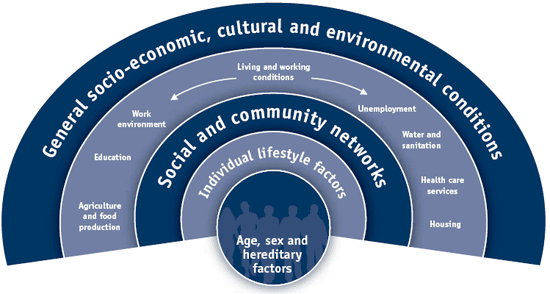Common menu bar links
Institutional links
Diseases & Conditions
Health & Safety
Research & Statistics
Agency Information
Search Box
E-mail this page
Report on the State of Public Health in Canada 2008
[Previous] [Table of Contents] [Next]
What we mean by public health
Canada is known throughout the world for its universal health-care system which is a major contributor to Canadians' health. But, as vital as its contributions are, there is more to health than good health care.
While health care focuses mainly on treating individuals, public health targets entire populations to keep people from becoming sick or getting sicker. Both work to limit the impacts of disease and disability.
One of the goals of public health is to promote physical and mental health as intricately connected to the environment and society we live in. The way Canada, as a society, deals with issues such as poverty, housing, sanitation and environmental protection influences the health of our population. Other factors also influence our health, including the presence or lack of family support and social networks, access to education and jobs, workplace safety, and strong communities.
Public health involves the organized efforts of society to keep people healthy and prevent injury, illness and premature death. It is a combination of programs, services and policies that protect and promote the health of all Canadians. |
Whose responsibility is public health?
Public health is a shared responsibility. While governments enact laws, develop policies and provide resources to fund public health activities, it takes the combined efforts of a variety of organizations, sectors, and people, both within and outside government, to address health challenges.
These joint efforts include everyone from physicians, nurses, public health inspectors and nutritionists, to community agencies, volunteer organizations, and the academic community; indirect players, such as the media that report health-related news; fitness instructors, adults who set good examples for children by taking care of their own health and employers who provide a work-life balance for their employees. To this list we can also add engineers and transportation workers who make Canada's highways safer, food producers who follow regulations to ensure that our food is safe, and not-for-profit groups who fight poverty and encourage Canadians to get active, recycle and reduce energy consumption.
About this report
The Chief Public Health Officer (CPHO) is required to report annually on the state of public health in Canada. The 2008 report is the first since the Public Health Agency of Canada became a legal entity in 2006. It provides both a snapshot of Canadians’ current health status and a benchmark against which we can measure future progress.
What we found
The overall health of Canada's population is considered very good, especially in comparison to many other countries. But a closer inspection of disease, disability and death rates shows that some groups of Canadians are less healthy and have a lower quality of life than others.
Because good health is not equally shared by all Canadians, it is essential that we understand the many factors that contribute to what we call health “inequalities” if we hope to develop solutions to turn this around.
Health inequalities are differences in health status experienced by various individuals or groups in society. These can be the result of genetic and biological factors, choices made, or by chance; but often they are because of unequal access to key factors that influence health, like income, education, employment and social supports. |
We know that age, sex and heredity are key factors that determine health. We also know that our lifestyle and behavioural choices matter, and that these factors are influenced by our environments, experiences, cultures and other factors. Finally, we know that for some, even when the best choices known are made, their health outcomes are limited by these broader influences.
There is good evidence that the following key factors have a profound effect on people's individual health behaviours and health outcomes:
- Social and economic influences, including income/poverty, early childhood development, education and literacy, and housing/homelessness.
- Our food security, that is, having access to enough nutritious and safe food to meet our health needs.
- How Canadian society is structured, from employment opportunities and working conditions, to the quality of our neighbourhood environments and even aspects of community design.
- Our social status and the work we do.
- Where we live, whether in urban or rural areas, whether in vibrant and prosperous communities or communities that are struggling economically and/or socially.
- Our social supports and connections, whether we have close family and friends who are there for us when we need them.
- Access to health care, which gives us access to prevention therapies, like vaccines, as well as access to advice about healthy living.
Factors that influence our health2

Why it matters
Public health asks two questions: What are the causes of poor health? How do we address those causes before they lead to health problems? |
Our goal is to be healthy for as long as possible. Disease and disability take a toll on affected individuals and their families as they suffer the physical, emotional, economic and social fall-out of poor health.
Aside from personal health and quality-of-life considerations, people who are less healthy put pressures on the health and welfare systems. This could lead to longer wait times and increase costs for Canadian taxpayers. There are also other costs to society, such as high rates of absenteeism and lower productivity in the workplace, which ultimately affect the standard of living and quality of life of all Canadians.
References
1 A Dictionary of epidemiology. 4th Edition. Oxford University Press.
2 Dahlgreen, G. & Whitehead, M., European strategies for tackling social inequities in health: Levelling up Part 2, World Health Organization, 2006.
[Previous] [Table of Contents] [Next]
